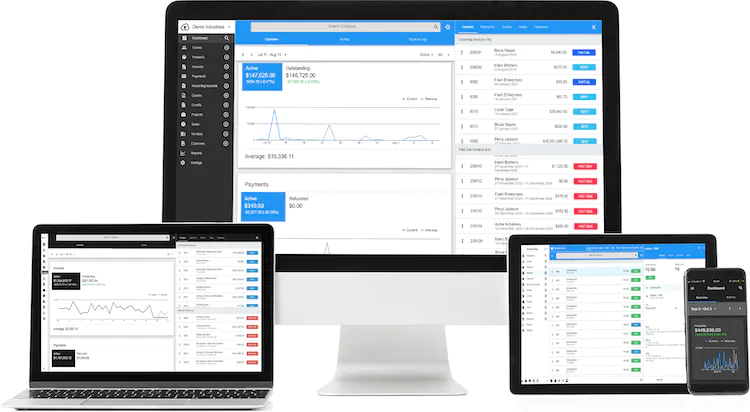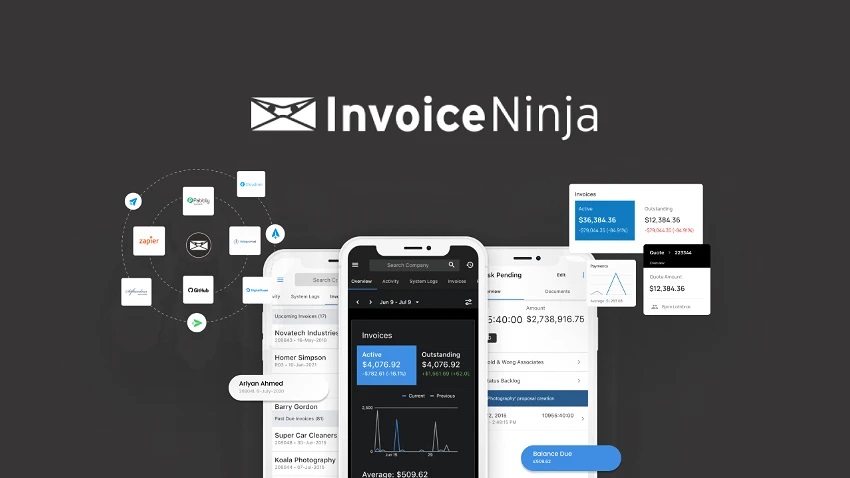What are SMTP settings and how do they relate to Invoice Ninja? How do you configure the SMTP settings in Invoice Ninja?
Let me explain.
In today’s digital age, efficient email communication is essential for businesses of all sizes.
Whether you’re sending invoices, quotes, or payment reminders, the seamless and reliable delivery of these messages is crucial.
This is where Invoice Ninja SMTP Settings come into play, offering a robust solution to enhance your email capabilities within Invoice Ninja.
This article will discuss Invoice Ninja SMTP settings, explaining their significance and guiding you through the setup process.
Let’s explore how configuring these settings can streamline your business communication and ensure your messages reach your recipients without a hitch.
But first, let’s understand Invoice Ninja and SMTP settings.
What is Invoice Ninja?
Invoice Ninja is a free invoicing software designed for small to medium-sized businesses and freelancers.
It allows users to create and send invoices, track expenses, manage clients, and accept payments.
Invoice Ninja is available as a self-hosted solution or a cloud-based service.
Key Features and Benefits of Invoice Ninja
Invoice Ninja offers a range of features, including invoicing, quotes, payments, expenses, time tracking, and project management.
You can create professional invoice templates, accept deposits and partial payments, and send invoices via Gmail or MSN accounts.
Invoice Ninja integrates with payment gateways across the world, allowing clients to pay invoices in one click.
The software also allows you to track expenses, create vendors, and organize categories.
Invoice Ninja offers multiple currencies and languages for overseas customers, automatic reminders for late payers, and the ability to transform quotes into invoices.
Why do you need to configure SMTP settings in Invoice Ninja?
SMTP settings need to be configured in Invoice Ninja to enable the software to send emails to clients directly from the software.
You may need to change the SMTP server settings if you switch email providers or if you encounter issues with sending emails.
You can edit the .env file and run php artisan optimize to change the SMTP server settings.
Configuring SMTP settings in Invoice Ninja ensures that emails are sent successfully and received by clients.
What is SMTP?
SMTP stands for Simple Mail Transfer Protocol. It is an application layer protocol used to transfer emails between different servers and computer networks.
SMTP is a push protocol used to send emails, whereas POP3 or IMAP is used to retrieve emails at the receiver’s side.
The role of SMTP in sending emails
SMTP is the standard email language used to send emails.
It defines the rules of communication between servers and email clients via the Internet.
SMTP is used to send emails from a sender to a recipient.
SMTP servers have specific addresses to communicate with other servers and mail clients.
Benefits of using SMTP for email delivery
SMTP helps increase email deliverability and reduce spam. It verifies the sender’s account before delivering an email, which helps prevent spam.
SMTP also makes it easy to send emails from different apps or devices.
The integration of SMTP doesn’t require advanced coding skills.
Additionally, SMTP service implies a fake SMTP server that captures outgoing mail, creating a safe environment for testing.
Setting up SMTP in Invoice Ninja
To set up SMTP in Invoice Ninja, follow these steps:
A. Accessing the Invoice Ninja dashboard
Log in to your Invoice Ninja account and access the dashboard.
B. Navigating to SMTP settings
Scroll down from the dashboard icon and click on the settings icon at the bottom of the dashboard to access the settings.
Select the “Email Settings” option from the advanced settings menu.
C. Inputting SMTP server details
Enter the SMTP server details, including the server name, port number, username, and password.
Choose the authentication method, such as SSL or TLS.
Input the email address and name that you want to use as the sender.
D. Authentication methods
Choose the authentication method that your email provider supports.
SSL and TLS are commonly used authentication methods.
E. SMTP port configuration
Enter the port number that your email provider uses for SMTP.
Common port numbers for SMTP include 25, 465, and 587.
F. Testing SMTP settings
After entering the SMTP server details, click on the “Test” button to verify that the settings are correct.
If the test is successful, you will receive a confirmation message.
G. Common issues and troubleshooting tips
If you encounter issues with sending emails, check that the SMTP server details are correct.
Make sure that the authentication method and port number are correct.
Check the logs in the storage/logs/laravel.log file for error messages.
If you are using Gmail, make sure that you have enabled “Less secure app access” in your Google account settings.
The steps to configure SMTP settings may vary depending on the version of Invoice Ninja you are using.
Recommended SMTP Providers
SMTP service providers help users send emails from their website to their users.
There are many SMTP service providers available, each with different features, pricing, and email delivery rates.
Some popular SMTP service providers include SendGrid, SMTP.com, Brevo, Mailgun, and Google Workspace.
Pros and cons of each provider
SendGrid is one of the largest and oldest service providers in email marketing and email delivery, but it can be expensive.
SMTP.com offers a robust API to send transactional emails and has one of the best deliverability rates, but it can be costly.
Brevo (formerly Sendinblue) offers a free plan for up to 1,000 monthly messages and affordable paid plans, but it may not be suitable for large businesses.
Mailgun offers a powerful API and email analytics, but it can be expensive for high email volumes.
Google Workspace is a popular choice for businesses that use Gmail, but it may not be suitable for high email volumes.
Each SMTP service provider has its own pros and cons, and users should choose the one that best fits their needs.
Step-by-step guide for setting up Invoice Ninja with a specific provider
To set up Invoice Ninja with an SMTP service provider, you need to access the Invoice Ninja dashboard and navigate to the Email Settings option.
You then need to input the SMTP server details, including the server name, port number, username, and password.
Ensure to choose the authentication method that your email provider supports, such as SSL or TLS.
You should also input the email address and name that you want to use as the sender.
After entering the SMTP server details, you can click on the “Test” button to verify that the settings are correct.
If you encounter issues with sending emails, they should check that the SMTP server details are correct, the authentication method and port number are correct, and check the logs for error messages.
Security and Best Practices
Importance of email security in Invoice Ninja
Email security is crucial for protecting sensitive information and maintaining the integrity of email communication.
You should implement strong email security practices to safeguard personal data, business assets, and reputation.
SSL/TLS encryption
SSL/TLS encryption is a security protocol that encrypts email data during transit.
You should enable SSL/TLS encryption to ensure that email data is protected from interception or unauthorized access.
SPF and DKIM authentication
SPF and DKIM are email authentication protocols that verify the sender’s identity and protect the message’s integrity.
You should implement SPF and DKIM authentication to prevent email spoofing and phishing attacks.
Protecting sensitive information
You should protect sensitive information, such as client data and financial information, by using end-to-end email encryption services.
You should also implement access controls and password policies to prevent unauthorized access to sensitive information.
Backup and recovery strategies
You should implement backup and recovery strategies to ensure that email data is not lost in case of a system failure or cyber-attack.
Regularly, back up email data and test the recovery process to ensure that it works effectively.
Customization and Branding
Using custom domains in SMTP settings
You can use custom domains in SMTP settings to personalize your email communication and improve brand recognition.
The custom domain should be properly configured and authenticated to prevent email delivery issues.
Personalizing email templates
You can personalize email templates to improve customer engagement and brand recognition.
Email templates should be professional and consistent with your brand image.
Branding your email communication
You can brand your email communication by using logos, colors, and fonts that are consistent with your brand image.
Ensure that your email communication is professional and consistent with your brand image.
Automation and Notifications
Setting up email notifications
You can set up email notifications to receive alerts for new invoices, payments, and other events.
Ensure that email notifications are properly configured and do not result in email overload.
Automated invoicing and reminders
You can automate invoicing and reminders to save time and improve efficiency.
Also, ensure that automated invoicing and reminders are properly configured and do not result in errors or delays.
Streamlining communication with clients
You can streamline communication with clients by using email templates, automated responses, and chatbots.
Additionally, ensure that communication with clients is professional, timely, and consistent with your brand image.
Integrations and Compatibility
How SMTP settings work with other Invoice Ninja integrations
SMTP settings enhance communication and data transfer with payment gateways and project management software.
Ensure proper SMTP configuration to work seamlessly with these integrations.
Compatibility with third-party tools
Invoice Ninja is compatible with CRM and project management software, streamlining data transfer for efficiency.
This involves proper configuration and integration of third-party tools with Invoice Ninja are essential.
Conclusion
Integrating SMTP settings with other Invoice Ninja integrations and third-party tools can enable seamless communication and data transfer.
By following these best practices, Invoice Ninja users can ensure that their email communication is professional, secure, and effective.






